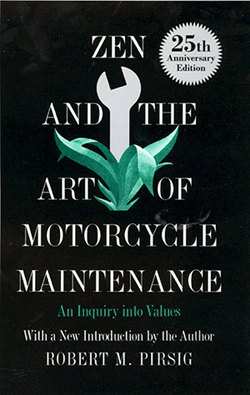
Robert Pirsig’s Zen and the Art of Motorcycle Maintenance: An Inquiry into Values follows the physical and spiritual journey of a writer of technical manuals who is travelling by motorcycle across mid-western America with his young son.
During the journey, the narrator revisits his past in which his former self, whom he refers to as Phaedrus, suffered a mental breakdown and underwent electroconvulsive therapy, with the result that the narrator has almost complete amnesia of his former life.
As they travel across America, the narrator contemplates the nature of existence and gradually works towards remembering and coming to terms with his past.
Taoist and Buddhist Concepts
Although the religious philosophy that Pirsig’s novel ostensibly explores is Zen Buddhism, a number of concepts from philosophical Taoism also appear in the novel. From the opening pages, the narrator’s motorcycle journey is closely associated with a number of ideas from philosophical Taoism and Zen Buddhism.
The narrator’s description of the landscape at the beginning of the novel—he refers to the life in the marshes along the road as living in “a kind of benign continuum”—corresponds to the idea of the Tao as a kind of rhythm or process, and references the Zen and Taoist recognition of all life’s inherent goodness.
Later in the novel, the narrator decides that it is wrong to call the marshes benign: “You could just as well call them cruel and senseless, they are all those things.”
The narrator’s recognition that the reality of nature cannot be summed up in a simple definition expresses the Zen and Taoist belief in the inadequacy of verbal expression.
Like Laotse, the narrator realizes that “He who knows does not speak; / He who speaks does not know.”
And yet, like Laotse, the narrator struggles with this paradox, for in order to impart his ideas to his reader he must use the medium of verbal expression.
The narrator’s description of the landscape through which he is travelling also expresses the Taoist appreciation of emptiness and the concept of wu wei.
The countryside of the Central Plains is “a kind of nowhere, famous for nothing at all and has an appeal because of just that.” It is “tranquil and detached,” two important Taoist values, and the narrator simply wants to appreciate the vast emptiness of the grassy fields: “I don’t want to own these prairies, or photograph them, or change them, or even stop or even keep going.”
In the narrator’s desire to travel without motivation—no desire to own, or change, or make progress—we see one of the central concepts of Taoism, wu wei, which is described by Laotse as “action without deeds.”
However, although the aim is to travel without motivation, there is something to be noticed on the journey, something that can be noticed because of the emptiness of the landscape, but which the narrator cannot define: there is “a thing that exists here because everything else does not and can be noticed because others things are absent…It’s here, but I have no names for it.”
The narrator’s inability to name the thing that exists in the fields recalls Laotse’s description of the Tao as elusive and evasive.
Selfishness as a Barrier to Inner Peace
Although the post-breakdown narrator views the world around him with the help of Zen and Taoist concepts, he describes his former self, Phaedrus, as struggling with the application of Eastern thought to his everyday life.
He tells us, for example, that “Phaedrus never got involved in meditation because it made no sense to him.” In contrast, the narrator spends his time on the motorcycle “being aware of things and meditating on them,” which is consistent with Zen and Buddhist meditation practices.
According to the narrator, Phaedrus believes it is his egotism that has prevented him from embracing Eastern thought in his approach to the world around him.
On a pilgrimage to holy Mount Kailas in India, Phaedrus was unable to complete the journey, not because he lacks physical strength or intellectual motivation, but because he thought “he was trying to use the mountain for his own purposes and the pilgrimage too.”
Here we see the selfishness that the Buddhist would identify as a cause of suffering and the Taoist as a hindrance to harmony with the Tao. As the philosophical Taoist Chuangtse points out, “the perfect man ignores self.”
The post-breakdown narrator of Zen and the Art of Motorcycle Maintenance, who is simultaneously attempting to retrieve some of his lost memories, repress his former self, and find a new self, recognizes many of what he sees as Phaedrus’ past errors and thus tries to develop a new way of approaching the world around him.
Yet Pirsig suggests that there must be a blending of the narrator and his former self—the narrator with his new perspective and the old Phaedrus with his profound ideas—for the narrator to achieve real harmony.
While it is Phaedrus who resurfaces at the end of the novel, indicated by Pirsig’s use of sans serif text, it is clear that it is a Phaedrus tempered by the “right attitudes” developed by the narrator throughout the course of the novel.
Source : http://philosophybooks.suite101.com




